EDITOR'S NOTE:
You know, my idiot writer saw this once, once in an arcade and they were too short to play it. Did you know, were you aware, that the writer of Gaming Hell has historically always been a shorty? Why d'ya think their name is Ant?! Sorry, getting distracted. So for this one, we didn't have access to an Under Fire arcade cabinet, and unlike Operation Wolf 3, the gun isn't a joystick masquerading as a gun. It's a genuine gun game, with state-of-the-art infrared or IR tech! That means mouse control was disqualified for research purposes. Instead, as is the Gaming Hell way, we improvised with a USB Wii sensor bar. It's not perfect, but it does the job close enough for our purposes, so we hope this is good enough. Also, we normally don't mess with emulator video settings too much, but as it is Under Fire is way too bright in MAME, so we toned the Gamma and Contrast settings down a little so it looks a little closer to how it would in a real arcade.
Finally, special thanks to Ultra Powerful Pal of Gaming Hell, HokutoNoShock, for some assistance with identifying the guns used in the game and other bits and bobs.
If you've seen screenshots of this game before, I know what you're thinking, you're thinking, "Taito ripping off Lethal Enforcers. Again".
I know it's hard to believe, but Lethal Enforcers was a big deal back in the early '90s!

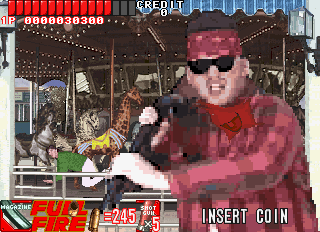
Anyway. This was, in fact, Taito's first attempt at a light gun game with digitised graphics, released early in 1994. Operation Wolf 3 came out later in the year and while from a game mechanics perspective both diverge from Lethal Enforcers in their own ways, Under Fire skews a little closer to Konami's approach to presentation and especially setting. It's a good ol' cops versus bad guys set-up, as the unnamed city of the game (I like to think it's Crime City after Tony & Raymond went on vacation) has found itself in the midst of chaos thanks to a criminal group called the Hoppers who have slowly taken control and made the city a living hell. With the normal police out of options as the situation gets out of control, the mayor has no choice but to call in a specially-trained police force, described by the amazing intro as "truly brave men who fight with a dedication to justice and an abhorrence for evil". These are the special police, and against the Hoppers, they are... Under Fire. See, that's how you do a title drop.

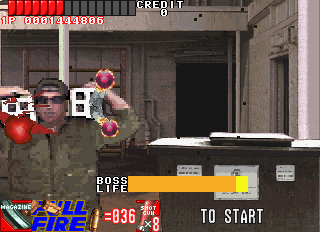
What makes Under Fire particularly remarkable is the technology behind its light guns, and how it solved one of the oldest problems with light gun games of the era. The vast majority of arcade games in the genre at the time used techniques for the controller that necessitated the screen flashing white every time you fire a shot. This can be a problem for people with sensitivity to light or epilepsy, and even if you're not affected by anything like that, it can get pretty intense on the ol' peepers. To combat this, Under Fire used infrared sensors instead in a box inside the cabinet, shown in this off-screen footage on boot-up and this method is briefly explained on Wikipedia over here. With this method, no screen-flashing is needed for the gun to operate, so you won't see it constantly flash! If anything, Under Fire was remarkably ahead of its time- while not adopted by the competition, this method of light gun control would be adopted by modern arcade games in the genre once CRT televisions were starting to be phased out, and even the Wii Remote uses something similar! This, however, may have worked to the game's detriment in terms of sales, as we'll find out later.
The other difference with Under Fire is the gun, something that more directly impacts the game mechanics. Instead of a service revolver like Lethal Enforcers or a mounted uzi like Operation Wolf, Under Fire is played with a very loose facsimile of a Heckler & Koch MP5, a submachine gun commonly used SWAT teams in the United States at the time of the game's release, and so a fitting choice for the storyline (the original flyer shows the guns as being based on the MP5KA4 model, but it seems the final design was something slightly more generic). In terms of the game itself, this means that you have a magazine of 24 bullets to work with, firing 3 bullets every time you pull the trigger and you reload by shooting off the screen. As well as giving you more shots to fire off before you have to reload, you can move the gun as you fire off the three-round burst and spread them out to hit multiple targets, which in particular makes bosses and mobs of enemies more of a manageable threat. It does take some getting used to, mind- when you first start playing, it can be weird to see enemies get shot multiple times just from pulling the trigger once which may throw you off- but after a few credits, you learn how it works. Unlike Lethal Enforcers and its ilk, you can't pick up extra weapons like grenade launchers here, but you can find Full Auto items that give you a rapid fire, hold-the-trigger shot with limited ammo (this also lets you fire just one bullet at a time if you want to save them) and you have a limited number of shotgun blasts, used with an extra button on the gun- this is similar to the bomb in Operation Wolf 3 but while it covers much less ground, it's very handy for when lots of projectiles are heading your way, and has the bonus of not killing innocent bystanders (and we'll get back to them).
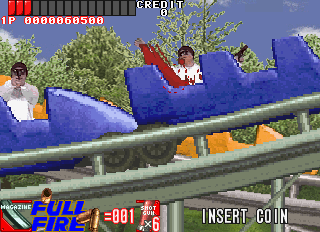

The structure of the rounds is pretty standard, in that you're mostly on static screens that scroll (with some chase sequences, in this case in Rounds 1 and 3) and they usually culminate in a boss battle. Where Under Fire makes itself distinct from Lethal Enforcers in one very important area: pacing. Aside from maybe the first scene, everything is a lot faster here- whereas in Konami's game you tend to have a brief moment between each enemy showing up, Under Fire hasn't got a second to live and makes sure there's almost never a quiet moment, keeping up a fairly hectic pace throughout, always ensuring the screen has a threat or something happening. It's a little overwhelming at first, especially in the later rounds, but you're well-equipped for the job with your gun (much more so than in Lethal Enforcers) and for the most part it doesn't feel unfair- you have to be quick but there is usually enough time to react to enemies before they can get a shot in, and there's nothing like enemies that attack you with no way to stop them, it's one shot, one kill here except for bosses. Speaking of the bosses, they're actually a highlight, especially when compared to Lethal Enforcers. Most of them are unique gang members rather than machines or vehicles and they duck behind cover and get right up in your face (the first boss of the game even moves his cover, a popcorn stand, to evade you). Vehicle bosses in this genre, especially at the time, could be long drawn-out affairs (that bloody Revolution-X helicopter) so it's in Under Fire's favour that it avoids them- the only real one is the truck in Round 3 who tries to City Escape you, and you can stop it from ramming into you by shooting it enough.
It's definitely got challenge to it- whereas Operation Wolf 3 felt like it was an attempt (key word: attempt) at being a more approachable, friendlier light gun game (with its very clear differentiation between hostiles and innocents and warnings before hostages even appear, enemies flashing before firing at you, the aiming reticle, the bomb being super-powerful, and so on), Under Fire goes in a bit harder, but with a couple concessions. Things like innocents having no warning before they appear (and they take two health blocks off you if shot), no super bomb, health only being restored by one block if you shoot someone holding a hostage and two blocks after each stage if you reach certain bonus / accuracy thresholds, and the sheer rate at which enemies appear offer the challenge, but then your versatile gun, the longer health bar (even though some attacks shave off two blocks) and the lack of non-boss enemies that take multiple hits gives you a little leeway. Not that I'm nearly good enough to do a proper one-credit clear of this game, mind you, but with the right strategy and lots of practice, it certainly seems more feasible than others in the genre. It is kinda funny that the innocents who get in the way are actually the biggest threat to your livelihood- they appear a lot and man, two blocks off your health for winging them is rough.
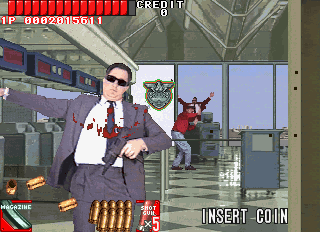

... Well, it's almost more viable for skilled play, because the challenge does get a little much in Under Fire's weakest element, the Accident / Undergo Training system which happens after Rounds 2 and 4. After defeating the bosses here, you may be told 'You Need Training' and be taken to Undergo Training, similar to the bonus stages in Lethal Enforcers where you have to shoot cardboard cutouts (shoot the bad guys, don't shoot the innocents), otherwise you're taken to a very short Accident stage, where you are completely swarmed by enemies for about 30 seconds. For the longest time, I assumed this was linked to your accuracy, not unlike the Mega Drive and Mega-CD ports of Lethal Enforcers which locked you out of proceeding to the next stage until you got an acceptable level of accuracy, but while I can't narrow down the specific requirements, it seems to lean heavily on the continues used as well as your general performance- any more than two before the end of Round 2 sends you to training, and it seems six or above sends you to training after Round 4. At the very least, this makes sense- players who are skilled enough get the opportunity for a huge points bonus, while those struggling get a safe chance to practice their sharp-shooting skills. I'm in two minds about this- on the one hand, it fits well with Under Fire having more challenging elements, and with a lot of practice, you can get through these. However, they're such a huge spike in difficulty that when you reach the point that you can consistently reach them, they become a wall of sorts, determined to take your credit from you, and I can see them as being really off-putting, bordering unfair! Fairness is a legitimate concern in this particular genre- at the time, Western-developed games like Terminator 2 and Revolution-X were literally impossible to complete on one credit (apparently even tool-assisted speedruns can't achieve this on those games, some damage cannot be avoided and there aren't enough health pickups to compensate). In this regard, Under Fire almost gets the balance just right, but those Accident stages are maybe too much.
Under Fire's real charm point is in the absurdity it revels in. Lethal Enforcers is a little silly with its clown-car gangster rides in the chase sequences and the audacity of its helicopter boss at the end, but Under Fire dials it up to 11. The frantic pace is definitely part of this, but there's stuff like the opening stage's carnival area where you have a high-speed chase on a rollercoaster, the level of destruction you can inflict on the backgrounds (you want to trash the convenience store? Hell yeah you can), and enemies just getting straight-up in your face Operation Wolf style. The presentation may be an acquired taste- the colour palette is very much brown-and-grey most of the time, but it doesn't feel nearly as dishwater-dull as Operation Wolf 3, and there's at least more variety for its locales, like an airport and a fancy office- but much like Operation Wolf 3, the character animation is really impressive, with way more frames given to characters than in Lethal Enforcers. Oh, and there's also the voices. My goodness, the voices. Similar to Lethal Enforcers, the Hoppers are very keen to trash-talk you, but unfortunately they only have three phrases (four in the Japanese version, we'll get to that)- "YAAAAHAHA!", "WHADDYA THINK OF THAT?" and female bad guys get "KILL YOU!". The game's soundscape is basically a constant barrage of gunfire, explosions, and these three phrases interspersed with screams and, of course, "DON'T SHOOT!" from hostages. Somehow, this never stops being funny, and with the frantic pace of the game, it's just a constant stream, yet it always makes me laugh. Even better, the bosses get their own catchphrases, including Double Rocket Launcher Man's "GET OUTTA MY FACE", and they're just wonderful.
Oh... And then there's the final boss.

NICE TO SEE YOU!
NOW GET READY TO SAY YOUR FINAL GOODBYES, SUCKER!
GET HIM!
He even gets a dramatic zoom-in and subtitles!
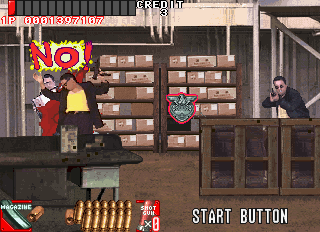

So with my reservations about the Accident stages aside, Under Fire seems like a pretty good game, right? How come it didn't become a household name like Lethal Enforcers did, was it just the lack of a home port? Putting on my detective hat, let's go back to those fancy guns the game used and how they may have hurt Under Fire's chances, putting together a few otherwise-unconnected facts can help paint a picture of why you were less likely to see a cabinet of this one than its contemporaries. The old version of the arcade-history page for the game mentioned something about the game being very expensive for arcade operators to buy- it's no longer there, and it's a completely unverified claim, but I can believe it- this wasn't your standard light gun set up, after all. Furthermore, looking at the Lethal Enforcers operators manual lists a nice extra to sweeten the deal- a cheap 'conversion kit' you could order from Konami when the game had stopped earning as much to change it into a JAMMA-compliant cabinet and put whatever you like in there. If there's one thing arcade operators hate, it's 'dead wood'- cabinets that aren't earning money and can't be repurposed into something else. Under Fire's operators manual has no such tempting offer, and the machine looks to take up slightly more floorspace. Obviously, all of this is just me putting some unconfirmed stuff together, and by no means a confirmed reason for why you probably didn't see an Under Fire cabinet with the same frequency as Lethal Enforcers, but it's something to think about.
It's a shame too, because I really like Under Fire! It certainly has its issues- mostly the Accident stages, but some may be turned off by the lack of weapon variety and the voice clips are either going to be completely hilarious or drive you nuts- but the breakneck pace of the action, the interesting choice of weapon for the time, and the presentation honestly make it a favourite of mine in the genre. It really grew on me as I was playing through it for this article, and I'd definitely pick this over Lethal Enforcers in an arcade if, uh, I could ever find a dang cabinet of it. If you do ever find one (haha, yeah right) or you have a way of simulating the experience properly at home, then it's a nice little blaster for half an hour. Who knows, maybe you'll get good enough at it to beat it in one credit too!
For answering 'whaddya think of that' with a resounding 'pretty good!', Under Fire is awarded...

In a sentence, Under Fire is...
An action movie through the lens of Taito.
And now, it's that time, folks!
EXTENDED PLAY!
An article about Under Fire without the amazing intro seems like a mistake. So, here it is:
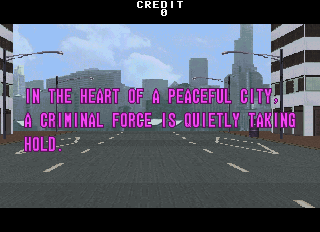
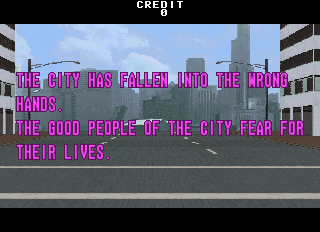

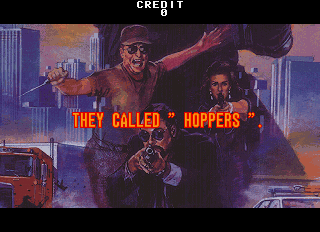
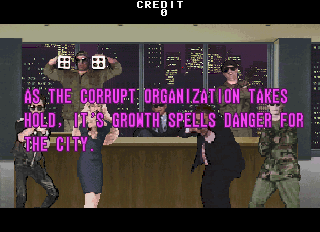



Under Fire has another thing in common with Lethal Enforcers- both have one (1) voice clip found in the Japanese version snipped from international releases!
One of the enemy shouts, "GO TO HELL!" is only in the Japanese version.
(It even plays during the attract mode! In particular, you'll hear it when the enemy smashes the screen from close-up.)
As far as I know, beyond things like text language and the Recycle It, Don't Trash It screen, this is the only difference between versions.
There's also a voice clip unused in all versions.
Each round has an intro from headquarters, briefly explaining what your mission is.
This one goes unused:
"We've got a fix on the route they're using to bring in the narcotics. Get down to South America as fast as you can!"
So this is an interesting one! Round 4, titled Crack House Raid, starts with a clip explaining "We've located the narcotics depot. Get over there right away!", but Round 5, Airport Escape, has a more generic clip that says "It's dangerous territory from here on. So let's be careful!". Additionally, Round 5 doesn't have a proper boss (just a brief encounter with a helicopter you can't destroy) and abruptly tells you to go to the Hoppers' headquarters. Perhaps the intention was for Round 5 to start with the clip about the narcotics route, with another round before the final one being a trip to South America, but this round was cut from the final game. For the better, I'd say- the game's just about the right length!
... Just one more thing, something sent into us by @TheOpponent about the final, final boss.
After you defeat his underlings, the Big Bad of the Hoppers gets up from his chair to fill you full of lead.
Most players will probably just shoot him, sending him out the window.
If you don't fire though, his shots won't even hurt you- he must be a bad shot- and...

... His gun backfires on him, sending him reeling backwards to his death!
Now that's a Taito ending!
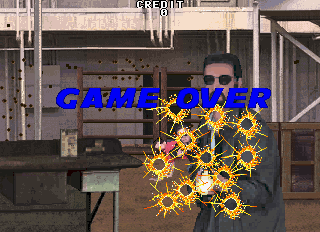
Slowly running out of Taito games that use digitised graphics.
Ring Rage is next, right? Right?!























